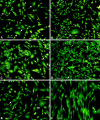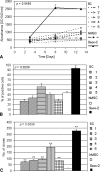Histogenetic characterization of giant cell tumor of bone
- PMID: 18543051
- PMCID: PMC2492994
- DOI: 10.1007/s11999-008-0327-z
Histogenetic characterization of giant cell tumor of bone
Abstract
The unpredictable behavior of giant cell tumor (GCT) parallels its controversial histogenesis. Multinucleated giant cells, stromal cells, and CD68(+) monocytes/macrophages are the three elements that interact in GCT. We compared the ability of stromal cells and normal mesenchymal stromal cells to differentiate into osteoblasts. Stromal cells and mesenchymal cells had similar proliferation rates and lifespans. Although stromal cells expressed early osteogenic markers, they were unable to differentiate into osteoblasts but they did express intracellular adhesion molecule-1, a marker of bone-lining cells. They were unable to form clones in a semisolid medium and unable to promote osteoclast differentiation, although they exerted a strong chemotactic effect on osteoclast precursors. Stromal cells may be either immature proliferating osteogenic elements or specialized osteoblast-like cells that fail to show neoplastic features but can induce the differentiation of osteoclast precursors. They might be secondarily induced to proliferate by a paracrine effect induced by monocyte-macrophages and/or giant cells. The increased number of giant cells in GCT may be secondary to an autocrine circuit mediated by the receptor activator of nuclear factor kB.
Figures






References
-
- {'text': '', 'ref_index': 1, 'ids': [{'type': 'DOI', 'value': '10.1002/path.1711470302', 'is_inner': False, 'url': 'https://doi.org/10.1002/path.1711470302'}, {'type': 'PubMed', 'value': '4067733', 'is_inner': True, 'url': 'https://pubmed.ncbi.nlm.nih.gov/4067733/'}]}
- Athanasou NA, Bliss E, Gatter KC, Heryet A, Woods CG, McGee JO. An immunohistological study of giant-cell tumour of bone: evidence for an osteoclast origin of the giant cells. J Pathol. 1985;147:153–158. - PubMed
-
- {'text': '', 'ref_index': 1, 'ids': [{'type': 'PubMed', 'value': '7285463', 'is_inner': True, 'url': 'https://pubmed.ncbi.nlm.nih.gov/7285463/'}]}
- Bauer FC, Urist MR. The reaction of giant cell tumors of bone to transplantation into athmic mice: including observations on osteoinduction in the host bed. Clin Orthop Relat Res. 1981;159:257–264. - PubMed
-
- {'text': '', 'ref_index': 1, 'ids': [{'type': 'PubMed', 'value': '3056645', 'is_inner': True, 'url': 'https://pubmed.ncbi.nlm.nih.gov/3056645/'}]}
- Bertoni F, Present D, Sudanese A, Baldini N, Bacchini P, Campanacci M. Giant-cell tumor of bone with pulmonary metastases: six case reports and a review of the literature. Clin Orthop Relat Res. 1988;237:275–285. - PubMed
-
- {'text': '', 'ref_index': 1, 'ids': [{'type': 'DOI', 'value': '10.1126/science.279.5349.349', 'is_inner': False, 'url': 'https://doi.org/10.1126/science.279.5349.349'}, {'type': 'PubMed', 'value': '9454332', 'is_inner': True, 'url': 'https://pubmed.ncbi.nlm.nih.gov/9454332/'}]}
- Bodnar AG, Ouellette M, Frolkis M, Holt SE, Chiu CP, Morin GB, Harley CB, Shay JW, Lichtsteiner S, Wright WE. Extension of life-span by introduction of telomerase into normal human cells. Science. 1998;279:349–352. - PubMed
-
- {'text': '', 'ref_index': 1, 'ids': [{'type': 'DOI', 'value': '10.1007/s002560050230', 'is_inner': False, 'url': 'https://doi.org/10.1007/s002560050230'}, {'type': 'PubMed', 'value': '9151375', 'is_inner': True, 'url': 'https://pubmed.ncbi.nlm.nih.gov/9151375/'}]}
- Brien EW, Mirra JM, Kessler S, Suen M, Ho JK, Yang WT. Benign giant cell tumor of bone with osteosarcomatous transformation (‘dedifferentiated’ primary malignant GCT): report of two cases. Skeletal Radiol. 1997;26:246–255. - PubMed
Publication types
MeSH terms
LinkOut - more resources
Full Text Sources
Other Literature Sources
Medical

